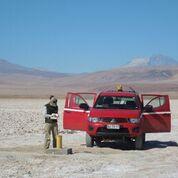

UMass Amherst graduate student Lilly Corenthal making notes at one of the largest lithium brine and salt deposits in the world, a deposit 3,900 feet thick in Chile's Atacama Desert, with the Andes Mountains in the background. The basin drains a surprisingly larger area of the Andean Plateau than geoscientists had expected.
Credit: UMass Amherst
A recent research report about one of the largest lithium brine and salt deposits in the world in Chile's Atacama Desert by geoscientists from the University of Massachusetts Amherst is the first to show that water and solutes flowing into the basin originate from a much larger than expected portion of the Andean Plateau.
The astonishingly massive evaporite deposit, 3,900 feet (1,200 m) thick, appears to be draining an area far larger than a map-based or topographic watershed would suggest, says lead hydrologist David Boutt.
The brine volume present, contrasted with the relatively small surface drainage in such an arid area, poses fundamental questions about both the hydrologic and solute budgets at plateau margins, that is the relationship between input and accumulation, the authors say. Their answers should aid understanding of the water and mineral resources in one of the world's driest regions.
As Boutt explains, “The amazing finding is the fact that most of the water is originating from outside the topographic watershed, on the Andean Plateau, and it's draining an area four or five times bigger than the watershed. There is no outlet to this basin and it is capturing an unbelievably huge volume of water in an otherwise extremely arid environment.” Details appear in a recent early online edition of Geophysical Research Letters.
Boutt and first author Lilly Corenthal, his former graduate student, say the physical and chemical connections between active tectonics, slopes, discharge zones and aquifers are not well characterized. In fact, they do not yet understand the conditions under which the massive evaporate deposit formed. Thus, the Chilean salt flat, Salar de Atacama, provides “a unique case-study to investigate questions about sub-surface fluid flow on the margins” of the Central Andean Plateau and others like it where mountain building forces are still active, they point out.
A drainage area that is several times larger than the topographic catchment is more common than people think, Boutt notes. “You can't assume that the surface catchment and ground water catchment are the same, and it tends not to happen in humid areas. But in dry areas–his is the driest non-polar desert in the world–the difference can be extensive, as it is in this case. And, this water is very, very old,” he adds. In such closed basins, high concentrations of mineral deposits, in particular lithium brine, represent an increasingly important resource in high global demand.
The researchers collected 300 samples of freshwater and brine to analyze how much sodium is entering the basin. Boutt says, “knowing something about how much sodium is there now can help us reconstruct how much water must have been coming in over the 7 to 10 million years as the Andes plateau uplift was taking place. The high elevation regions of the Andes are like wicks pulling water out of the atmosphere and putting it into the basin,” he adds.
They also used satellite precipitation data to “backsolve” the brine's origins using sodium concentrations, oxygen and hydrogen isotopes, as the isotopic composition of water reflects the condensation temperature and precipitation rate over time. The main controls are source of the moisture and condensation temperature, and whether or not the water has experienced evaporation, Boutt notes.












